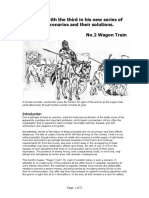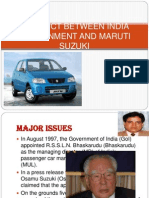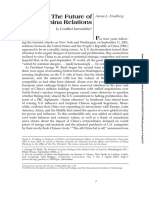0 ratings0% found this document useful (0 votes)
7 views11C US China Relations
11C US China Relations
Uploaded by
ayeshasiddiqa.9525Copyright:
© All Rights Reserved
Available Formats
Download as PDF, TXT or read online from Scribd
11C US China Relations
11C US China Relations
Uploaded by
ayeshasiddiqa.95250 ratings0% found this document useful (0 votes)
7 views7 pagesCopyright
© © All Rights Reserved
Available Formats
PDF, TXT or read online from Scribd
Share this document
Did you find this document useful?
Is this content inappropriate?
Copyright:
© All Rights Reserved
Available Formats
Download as PDF, TXT or read online from Scribd
Download as pdf or txt
0 ratings0% found this document useful (0 votes)
7 views7 pages11C US China Relations
11C US China Relations
Uploaded by
ayeshasiddiqa.9525Copyright:
© All Rights Reserved
Available Formats
Download as PDF, TXT or read online from Scribd
Download as pdf or txt
You are on page 1of 7
Ammar Gul
03345064202
Multi-dimensional US-China Relations: Rivalry,
Competition and Cooperation.
According to U.S. Secretary of State Antony Blinken, US relations with
China are multifaceted, comprising elements of cooperation,
competition, and systemic rivalry.
Multi-dimensional US-China Relations:
Adversarial dimension of Sino-US Relations:
China poses the “most serious long-term challenge to the international
order: US Secretary of State Antony Blinken.
1. US-China Trade War:
It’s now clear to U.S. officials that China, once
considered a possible economic and political ally, has
become an emerging threat to national security, U.S.
companies and American workers, Commerce
Secretary Gina Raimondo.
China-U.S. trade fell by 14.5% in the first half of the
year 2023: China’s ambassador to the U.S., Xie Feng.
Decoupling of economies: Trump imposed 360 billion
tariffs on Chinese goods.
Xie claimed that average U.S. tariffs on Chinese
products were 19%, while the Chinese tariffs on U.S.
goods averaged 7.3%.
Trump and Biden imposed tariffs on Chinese goods
and China retaliated in the same manner.
Biden’s “de-risking” Strategy: intends to narrowly
tailor restrictions to prevent China’s military
advancement and protect U.S. national security
New Executive Order 2023: declaring a national
emergency to deal with the threat of advancement by
countries like China “in sensitive technologies and
products critical to the military, intelligence,
surveillance, or cyber-enabled capabilities”.
The US treasury secretary to prohibit or restrict
certain US investments in Chinese entities in three
sectors: semiconductors and microelectronics,
quantum information technologies, and certain
artificial intelligence systems.
2. The US-China Tec War:
China banned Face book, Google, Apple and You tube
to operate in China.
US CHIPS and Science Act 2022: Designed to boost US
competitiveness, innovation, and national security.
The law aims to catalyze investments in domestic
semiconductor manufacturing capacity.
The act invests $280 billion to bolster US
semiconductor capacity, catalyze R&D, and create
regional high-tech hubs and a bigger, more inclusive
STEM workforce.
US-China Chips war: US is concerned that China is
using chips to advance its military technology, Xi’s
vision of “world class” military by 2049,
Semiconductors., Semiconductors are used to
produce hypersonic missiles, and using artificial
intelligence (AI) for a range of applications, including
electronic warfare.
US banned China’s access to US-origin
semiconductors and their related products.
US sanctioned Chinese largest chip maker:
Semiconductor Manufacturing International
Cooperation.
US have banned the sale and import of new
communications equipment from five Chinese
companies, including Huawei and ZTE, amid concerns
over national security.
In March 2023, when Japan and
the Netherlands announced that they were also
adopting new export controls on advanced
semiconductor manufacturing equipment. Combined,
the U.S., Japan, and the Netherlands provide roughly
90% of all the equipment that is used in computer
chip factories worldwide.
China’s anti-trust authority has effectively
blocked any and all corporate mergers involving a
U.S. semiconductor company that operates in
Chinese markets.
China initiated a cyber security review of Micron, the
leading U.S. producer of memory chips. In late May,
China’s regulators banned purchases of Micron chips
in China’s critical infrastructure sector.
3. Geopolitical and geostrategic rivalry between US and China:
China is the biggest threat to the US interests and
security: National Intelligence Report.
China Containment Policy.
China-Russia no limit strategic partnership
AUKUS, QUAD, I2U2etc.
China-Iran Strategic Partnership.
IMEC versus BRI in Middle East.
China-US rivalry in Indo-Pacific
BRICS, SCO, NATO, Partners in Blue Pacific
Indo-Pacific Economic Framework versus
Regional Comprehensive Economic Partnership.
4. US-China Strategic Divergence on Taiwan, Hong Kong and Tibet.
5. Authoritarian versus democratic political order of the world:
According to the US Director of National Intelligence,
China poses the greatest threat to democracy and
freedom world-wide since World War 2.
6. Chinese model of Multilateralism and US model of Unipolarism:
GDI, GSI and GCI.
7. De-dollarization and the rise of Petroyuan.
Competitive Mode of US-China Relations:
1. Strategic competition of building infrastructural corridors:
BRI versus B3W.
IMEC, I2U2 etc.
Chinese Participation in the Greater Eurasian
Partnership.
2. Technological Competition between US and China:
Competition in Generative Artificial Intelligence:
OpenAI ChatGPT.
Chinsese AI Development Plan calling for Chinese AI
to be the world’s undisputed leader by 2030.
Competition in communication networks: Huwaei
launched 5G later T- Mobile Launched 5G across the
US.
Technological competition in modernizing military:
Xi’s vision of a "world-class" military power, capable
of "fighting and winning wars" by 2049.
3. US-China Competition in Cyberspace:
Eternal Blue VS Dubbed Daxin
4. US-China Competition in outer Space:
Tiangong Space Station vs NASA’s International Space
Station.
Beidou satellite navigation system vs Global
Positioning System.
Chinese anti-satellite Missile SC-19 ASAT vs US anti-
satellite missile RIM-161-Standard Missile-3.
Cooperative Phase of US-China Relations:
1. To Mitigate Global Conflicts:
Israel-Palestine Issue.
Kashmir Issue
Yemen Civil War
Civil Wars in Horn of Africa.
2. Global Cooperation to Counter-Terrorism:
IS-k, AL-Qeada, ETIM, TTP etc.
3. Global Cooperation to Counter Global Warming:
4. Global Cooperation on Natural Disasters.
5. Global Cooperation on Nuclear Proliferation.
6. Global Cooperation on developing health, educational and
innovative infrastructure
P
Positive developments between US and
o
China
s in recent times:
i
t • Bali Meeting between Biden and Xi in
i 2022:
v
Nov 14 (Reuters) - U.S. President
e Joe Biden and Chinese leader Xi
d Jinping held their first in-person talks
e since 2017 on the sidelines of the
v G20 summit in Bali, Indonesia
e Biden reiterated that the U.S. one-
l China policy with regard to Taiwan,
o the self-governed island claimed by
p Beijing, had not changed.
m Biden had raised objections to
e China's "coercive and increasingly
n aggressive actions toward Taiwan,"
t which he said undermined peace and
stability across the Taiwan Strait and
P
in the broader region, and
o jeopardized global prosperity.
s
i Xi too was explicit about Taiwan,
calling it the "first red line" that must
t not be crossed in China-U.S.
i relations.
v
e
Opening of communication channels:
The White House said Biden and Xi
agreed to "deepen constructive
efforts" to address issues such as
climate change, health and food
security.
Biden and Xi "underscored their
opposition to the use or threat of use
of nuclear weapons in Ukraine".
Referring to U.S. sanctions on
Chinese firms, Xi said China
opposed politicizing and weaponizing
e hnology.
c
o
On North Korea, Biden said he made
it clear to Xi that China had an
n
obligation to make sure North Korea
o
did not resume nuclear testing,
m
although it was difficult to determine
i
if Xi had that influence.
c
Antony Blinken’s visit to China 2023:
a
n
•
d The top U.S. diplomat and Xi both stressed the
t importance of having a more stable relationship, as
r any conflict between the world's two largest
a economies would create global disruption.
d
• Core issues: Taiwan, Ukraine war,
e
t
i
Sanctions of Chinese companies.
China-US e
summit held on November 15 2023
s
in San Francisco:
a
• sw They established the "San Francisco vision"
e oriented toward the future, providing direction
l and outlining a blueprint for the healthy, stable,
l and sustainable development of China-US
a
relations.
s
• e The two sides reached consensus on more than
x 20 issues in areas such as politics, diplomacy,
c
cultural exchanges, global governance, and
h
a military security on the basis of mutual respect,
n equality and mutual benefit.
• g China is ready to be a partner and friend of the
e
s US. XI
• i “For two large countries like China and the
n
United States, turning their back on each
s
c other is not an option,” Xi said in his
i opening remarks. “Planet Earth is big
e enough for the two countries to succeed.”
n
• c “We have to ensure that competition does
e not veer into conflict,” Biden said at the start
a of the summit. “Critical global challenges we
n
face, from climate change to
d
t counternarcotics to artificial intelligence,
e demand our joint efforts.
Conclusion.
c
You might also like
- The Chosen 2020 PDFDocument22 pagesThe Chosen 2020 PDFSARA.ISMAEAL3785No ratings yet
- Foreing Affair - No Substitute For VictoryDocument21 pagesForeing Affair - No Substitute For VictoryMiguel HernándezNo ratings yet
- Tamo Daleko Serbian Folk SongDocument1 pageTamo Daleko Serbian Folk SongGato 09No ratings yet
- America's Competition With China Must Be Won, Not Managed - Apr 2024 Foreign AffairsDocument17 pagesAmerica's Competition With China Must Be Won, Not Managed - Apr 2024 Foreign Affairspaolo.rombibisNo ratings yet
- The Road To CompetitionDocument3 pagesThe Road To CompetitionSaqibullahNo ratings yet
- Nye - Power and Interdependence With ChinaDocument16 pagesNye - Power and Interdependence With Chinaabycy2718No ratings yet
- The Inconvenient Truth: Aspirations Vs Realities of Coexistence Between "The West" and ChinaDocument5 pagesThe Inconvenient Truth: Aspirations Vs Realities of Coexistence Between "The West" and Chinarahul kadamNo ratings yet
- Power and Interdependence With ChinaDocument16 pagesPower and Interdependence With ChinazhouyaxinmtlNo ratings yet
- Blackwill USGRANDSTRATEGY 2020Document8 pagesBlackwill USGRANDSTRATEGY 2020gemmelljeNo ratings yet
- New AffDocument15 pagesNew Affwukongsun2018No ratings yet
- 2ac From DemoDocument8 pages2ac From DemoMatthew KimNo ratings yet
- China's Perspective On The Crisis With The United StatesDocument5 pagesChina's Perspective On The Crisis With The United StatesLia LiloenNo ratings yet
- New Cold War: International RelationsDocument3 pagesNew Cold War: International RelationsRukhsar TariqNo ratings yet
- China Relations DA - Michigan 2024 HHIRSDocument137 pagesChina Relations DA - Michigan 2024 HHIRSgunnym2397No ratings yet
- Blackwill USCHINARELATIONSDETERIORATE 2021Document7 pagesBlackwill USCHINARELATIONSDETERIORATE 2021lextpnNo ratings yet
- RSC Report CardDocument53 pagesRSC Report CardFox NewsNo ratings yet
- US, India Must Focus On Threat Posed by China - Secretary of State Mike Pompeo - Times of IndiaDocument2 pagesUS, India Must Focus On Threat Posed by China - Secretary of State Mike Pompeo - Times of IndiaAkhilGovindNo ratings yet
- US China Relations An OverviewDocument8 pagesUS China Relations An OverviewAnna KovalovaNo ratings yet
- DAILY EDITORIAL ANALYSIS-24th July 2020Document3 pagesDAILY EDITORIAL ANALYSIS-24th July 2020mohitpanda4005No ratings yet
- Ccas Cicir AssessmentDocument4 pagesCcas Cicir AssessmentMein HunNo ratings yet
- Propper ChinasPerspectiveCrisis 2020Document5 pagesPropper ChinasPerspectiveCrisis 2020lextpnNo ratings yet
- DA - Diplomatic Capital - DDI 2022Document158 pagesDA - Diplomatic Capital - DDI 2022anikakulkarni22No ratings yet
- A New Cold War: Trump, Xi and The Escalating US-China Confrontation - Financial TimesDocument17 pagesA New Cold War: Trump, Xi and The Escalating US-China Confrontation - Financial TimesYourick Evans Pouga MbockNo ratings yet
- IB Muneeb Apr-26 2024Document4 pagesIB Muneeb Apr-26 2024Hira SheikhNo ratings yet
- COVID-19 Effect and US-China NarrativesDocument18 pagesCOVID-19 Effect and US-China NarrativesMuhammad ShoaibNo ratings yet
- Moments of Clarity: Uncovering Important Lessons For 2023Document20 pagesMoments of Clarity: Uncovering Important Lessons For 2023The Wilson CenterNo ratings yet
- ARTICLE OF THE DAY - 26th DECEMBER 2023Document2 pagesARTICLE OF THE DAY - 26th DECEMBER 2023singhprincejnuNo ratings yet
- India-US Relations Under Biden Administration: PM ModiDocument15 pagesIndia-US Relations Under Biden Administration: PM Modipushpak deshmukhNo ratings yet
- Rajat ProposalDocument5 pagesRajat Proposalbrajatkumar99.comNo ratings yet
- Digital Media Discourse On The Blockage of Huawei by The US GovernmentDocument26 pagesDigital Media Discourse On The Blockage of Huawei by The US GovernmentB17No ratings yet
- Nov Dec 22 Topic AnalysisDocument8 pagesNov Dec 22 Topic Analysisvsbkdcx6d8No ratings yet
- 1 s2.0 S2590051X20300095 MainDocument27 pages1 s2.0 S2590051X20300095 Mainredminote13nihNo ratings yet
- In The News: Tweet of The WeekDocument4 pagesIn The News: Tweet of The WeekAmerican Enterprise InstituteNo ratings yet
- Whither Indo-U.S. Relations? (Topic 1)Document6 pagesWhither Indo-U.S. Relations? (Topic 1)Hari KiranNo ratings yet
- 中美研究中心:美国国会的中国牌:对未来中美双边贸易和科技交流的影响(英)Document47 pages中美研究中心:美国国会的中国牌:对未来中美双边贸易和科技交流的影响(英)成荣No ratings yet
- President-Elect Biden On Foreign PolicyDocument17 pagesPresident-Elect Biden On Foreign PolicyShahroz AsifNo ratings yet
- Millburn ChWa Pro Florida Blue Key Speech and Debate Tournament Round 2Document3 pagesMillburn ChWa Pro Florida Blue Key Speech and Debate Tournament Round 2hrishi8731No ratings yet
- Biden Says US Prepared To Beat China For 21st Century Competition Not Looking For Conflict With BeijingDocument4 pagesBiden Says US Prepared To Beat China For 21st Century Competition Not Looking For Conflict With BeijingVAISHALI BASU SHARMANo ratings yet
- Us China TusssleDocument3 pagesUs China Tussslejasson babaNo ratings yet
- DelbartonSchool-PaEh-Pro-3---Apple-Valley-Quarters (2)Document24 pagesDelbartonSchool-PaEh-Pro-3---Apple-Valley-Quarters (2)mayenm25No ratings yet
- Current Affairs Question by HammadDocument5 pagesCurrent Affairs Question by Hammadknowledgelearning35No ratings yet
- TBU Examining Biden's Evolving Indo Pacific Policy 1.0 Final Edit AR 1900 On 30aprilDocument20 pagesTBU Examining Biden's Evolving Indo Pacific Policy 1.0 Final Edit AR 1900 On 30aprilRohitNo ratings yet
- Geopolitical Strategic Importance of PakistanDocument4 pagesGeopolitical Strategic Importance of PakistanSyed Maaz HassanNo ratings yet
- China Not A ThreatDocument26 pagesChina Not A ThreatAkshay RamaswamyNo ratings yet
- NoneDocument9 pagesNoneyutuquins123No ratings yet
- Bapi DhalDocument5 pagesBapi Dhalbrajatkumar99.comNo ratings yet
- Way 2020CountryBrief 2020Document21 pagesWay 2020CountryBrief 2020Ricardo R.CepedaNo ratings yet
- 2020 Country Brief ChinaDocument21 pages2020 Country Brief ChinaminhNo ratings yet
- US or China ArtirclesDocument6 pagesUS or China ArtirclesSajad AhmedNo ratings yet
- 1110 - Truth Is Stranger Than Fiction Based On FactDocument18 pages1110 - Truth Is Stranger Than Fiction Based On FactAgada PeterNo ratings yet
- Issue Brief Cass CicirDocument5 pagesIssue Brief Cass CicirMein HunNo ratings yet
- TankelDocument10 pagesTankelxin.wangNo ratings yet
- Edina ElMe Con Apple Valley Minneapple Round 2Document11 pagesEdina ElMe Con Apple Valley Minneapple Round 2rajat.ravihnrNo ratings yet
- The Next Superpower and Opportunities For IndiaDocument5 pagesThe Next Superpower and Opportunities For IndiaAbhinav BaranwalNo ratings yet
- XuetongDocument6 pagesXuetongVasil V. HristovNo ratings yet
- Independent Global NewsDocument6 pagesIndependent Global NewsArthur QueirozNo ratings yet
- China Rise and The United States Response Implications For The Global Order and New Zealand Aotearoa. Part II The US Response Emergence of ADocument12 pagesChina Rise and The United States Response Implications For The Global Order and New Zealand Aotearoa. Part II The US Response Emergence of ADeth MingseuNo ratings yet
- America and China Try To Move Past A New Bump in RelationsDocument10 pagesAmerica and China Try To Move Past A New Bump in Relationsailes13158No ratings yet
- Florida Blue Key Invitational Round 1Document4 pagesFlorida Blue Key Invitational Round 1raven73008No ratings yet
- Report Part Title: US-CHINA STRATEGIC RIVALRYDocument3 pagesReport Part Title: US-CHINA STRATEGIC RIVALRYLia LiloenNo ratings yet
- Techno-Economics and National Security - The Strategic Clash Between TheDocument6 pagesTechno-Economics and National Security - The Strategic Clash Between TheunkownNo ratings yet
- Data Lansia PurwodadiDocument78 pagesData Lansia PurwodadihatilentheraNo ratings yet
- Accord VST GuideDocument8 pagesAccord VST GuideDrew Van der WerfNo ratings yet
- b-2 Stealth Bomber OutlineDocument2 pagesb-2 Stealth Bomber Outlineapi-269792721No ratings yet
- G20 - Study GuideDocument19 pagesG20 - Study GuideMade by AngieNo ratings yet
- Freedom Movement by SR JKDocument160 pagesFreedom Movement by SR JKHarsh PateriyaNo ratings yet
- AmbarSynopsisEN PDFDocument4 pagesAmbarSynopsisEN PDFJinish KGNo ratings yet
- 40 Maps That Explain The Roman Empire - VoxDocument47 pages40 Maps That Explain The Roman Empire - Voxrampant99100% (2)
- Ray Gun Revival Magazine, Issue 45Document75 pagesRay Gun Revival Magazine, Issue 45Johne Cook100% (3)
- Dungeon World Lore and Lords PackDocument23 pagesDungeon World Lore and Lords PackUmberto ManzaliniNo ratings yet
- Béla IV.Document2 pagesBéla IV.MihálySzücsNo ratings yet
- Pakistan National Security Policy 2022Document10 pagesPakistan National Security Policy 2022Tushar ParmarNo ratings yet
- Thesis On Dystopian LiteratureDocument6 pagesThesis On Dystopian Literatureafcmtzlda100% (2)
- C.S. Grant With The Third in His New Series of Wargames Scenarios and Their Solutions. No.2 Wagon TrainDocument5 pagesC.S. Grant With The Third in His New Series of Wargames Scenarios and Their Solutions. No.2 Wagon TrainAnonymous uqCzGZINo ratings yet
- Wargames Illustrated #031Document56 pagesWargames Illustrated #031Анатолий Золотухин100% (2)
- Battletech Domination v2.2 RULEBOOKDocument25 pagesBattletech Domination v2.2 RULEBOOKDavid San-Briones100% (1)
- An Introduction To Property ValuationDocument20 pagesAn Introduction To Property Valuationduch202033% (3)
- Conflict Between India Government and Maruti SuzukiDocument7 pagesConflict Between India Government and Maruti SuzukiArya AntonyNo ratings yet
- Notes: English Literature, GCE OL Examination, Sri Lanka 2017 - R.SubasingheDocument49 pagesNotes: English Literature, GCE OL Examination, Sri Lanka 2017 - R.SubasingheRathnapala Subasinghe91% (247)
- Battle of AmbarawaDocument11 pagesBattle of Ambarawaabu zahroNo ratings yet
- Ruthless Roscoe Same Script (Short)Document7 pagesRuthless Roscoe Same Script (Short)Ben JavidNo ratings yet
- Schroeder 5 Generation ReportDocument20 pagesSchroeder 5 Generation ReportKaren DwyerNo ratings yet
- Haldeman - Forever WarDocument101 pagesHaldeman - Forever WarМихаил КоньшинNo ratings yet
- Topic 1. Decline of The MughalsDocument8 pagesTopic 1. Decline of The MughalsMuhammad AhmadNo ratings yet
- MFC Atacms Block 1a Unitary PCDocument2 pagesMFC Atacms Block 1a Unitary PCVictor PileggiNo ratings yet
- Uscg Marine Crewman HandbookDocument588 pagesUscg Marine Crewman HandbookHasancan YavaşNo ratings yet
- The Future of U.S.-china RelationsDocument39 pagesThe Future of U.S.-china RelationsOscar VillarragaNo ratings yet
- Transcript ColloquimDocument28 pagesTranscript ColloquimEd Ravfhor Amen AmenNo ratings yet
- Erwin RommelDocument40 pagesErwin RommelValkiraValNo ratings yet

























































































